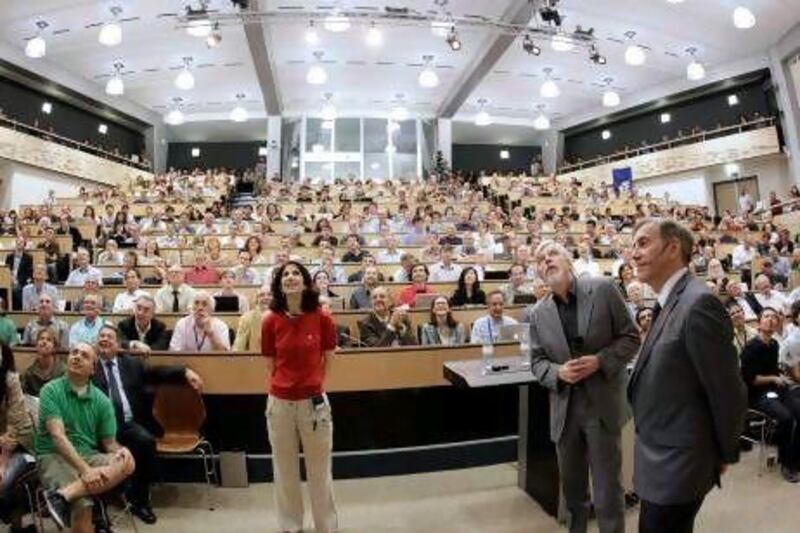GENEVA // To cheers and standing ovations, scientists announced the discovery of a new subatomic particle yesterday, calling it "consistent" with the long-sought Higgs boson which helps explain what gives mass to all matter in the universe.
"We have now found the missing cornerstone of particle physics," Rolf Heuer, the director of the European Center for Nuclear Research (CERN), told scientists.
He said the newly discovered subatomic particle is a boson, but he stopped just shy of claiming outright that it is the Higgs boson itself - an extremely fine distinction.
"As a layman, I think we did it," he told the elated crowd. "We have a discovery. We have observed a new particle that is consistent with a Higgs boson."
The Higgs boson, which until now has been a theoretical particle, is seen as the key to understanding why matter has mass, which combines with gravity to give an object weight. The idea is much like gravity and Isaac Newton's discovery of it: gravity was there all the time before Newton explained it. But now scientists have seen something very much like the Higgs boson and can put that knowledge to further use.
CERN's atom smasher, the US$10 billion (Dh36.7bn) Large Hadron Collider on the Swiss-French border, has been creating high-energy collisions of protons to investigate dark matter, antimatter and the creation of the universe, which many theorise occurred in a massive explosion known as the Big Bang.
Two independent teams at CERN said yesterday they have both "observed" a new subatomic particle - a boson. Mr Heuer called it "most probably a Higgs boson, but we have to find out what kind of Higgs boson it is".
"It is consistent with a Higgs boson as is needed for the Standard Model," Mr Heuer said. "We can only call it a Higgs boson - not the Higgs boson."
The leaders of the two CERN teams - Joe Incandela, the head of CMS with 2,100 scientists, and Fabiola Gianotti, the head of Atlas with 3,000 scientists - each presented in complicated scientific terms what was extremely strong evidence of a new particle.
Mr Incandela said it was too soon to say definitively whether it is the Standard Model Higgs that Scottish physicist Peter Higgs and others predicted in the 1960s - part of a Standard Model theory of physics involving an energy field where particles interact with a key particle, the Higgs boson.
Asked his opinion, Mr Higgs, who was invited to be in the audience, said he also could not yet say.
But he told the audience that the discovery of something that appears to be so close to what he predicted. "It is an incredible thing that it has happened in my lifetime," he said, calling it a huge achievement for the proton-smashing collider built in a 27-kilometre underground tunnel.
The stunning work elicited ovations and applause at a packed auditorium in CERN as Ms Gianotti and Mr Incandela each took their turn.
Mr Incandela called it "a Higgs-like particle ... we know it must be a boson and it's the heaviest boson ever found."
"Thanks, nature!" Ms Gianotti said to laughs.
Later, she told reporters that "the Standard Model is not complete" but that "the dream is to find an ultimate theory that explains everything - we are far from that."
Mr Incandela said the last undiscovered piece of the Standard Model could be a variant of the Higgs that was predicted or something else that entirely changes the way scientists think about how matter is formed.
"This boson is a very profound thing we have found. We're reaching into the fabric of the universe in a way we never have done before. We've kind of completed one particle's story," he said. "Now, we're way out on the edge of exploration."






